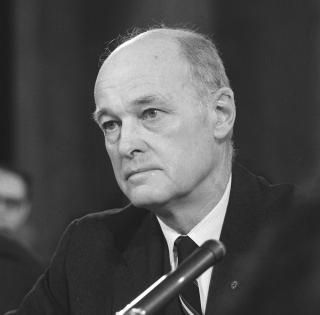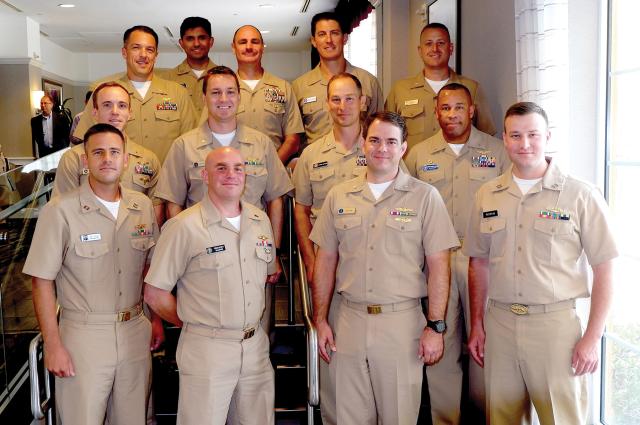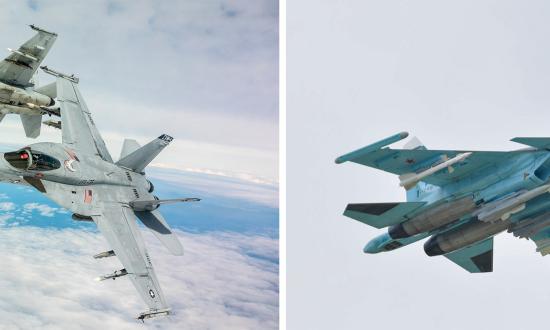One way to categorize naval intelligence professionals (officer, enlisted, or civilian) is to think of them as one of three types: Warhols, Kennans, and Murrays. Warhols, named for the late artist Andy Warhol, produce the bulk of the intelligence briefings and reporting and represent most of the workforce. Their day-to-day routines rarely change. They produce a version of the same product—imagery analysis of a port or airfield, a translation of intercepted communications, a morning intelligence brief—in roughly the same format. Formats and formatting matter to Warhols. Fonts matter, and font sizes perhaps even more. They keep the master template, and nothing drives them crazier than a slanted line on a PowerPoint slide.
Consider Andy Warhol’s lifelong fixation with the life and career of the actress Marilyn Monroe. Beginning in 1962, Warhol began experimenting with different ways of altering and presenting the same portrait of Monroe. He applied different combinations of colors to different parts of the image and added what could be described as “pre-digital Instagram filters,” all to highlight, express, or conceal one aspect or another of the same image. He produced hundreds of variations of this image throughout his career, and they remain wildly popular. Originals can sell for millions of dollars at auction. Reprints and posters hang in dorm rooms across the world.
Andy Warhol showed how to inject creativity and nuance into even the most rote and repetitive tasks. The Warhols of naval intelligence are not automatons; there is an artistry in doing what the best of them do well. Repeatedly making roughly the same type of thing—while also making new or important information stand out—is not easy. As they mature, naval intelligence Warhols will spend more time honing their craft to make what could be a mundane presentation or report as gripping and engaging as possible.
The Kennans are named for American diplomat George Kennan. Kennan had a long and varied career in diplomatic service before and during the Cold War. He is probably best remembered for his 1946 “Long Telegram,” in which he proposed a new way of thinking about the Soviet Union after World War II, based on his understanding of Russian history and firsthand experience working in the U.S. embassy in Moscow. The Long Telegram provided a comprehensive intellectual framework for policymakers in Washington dealing with the Soviet Union. Kennan was not the only person to attempt this, but his conceptualization, and the role it played in formalizing Containment Theory, was better than any of his peers’ efforts because of his deep understanding of the subject and recent experience working in the field.
Naval intelligence Kennans fall along a spectrum of capability and maturity. Good Kennans can frame a complex issue for audiences, drawing on an in-depth understanding of the subject matter, and glean insight from a variety of disparate sources. Bad Kennans are cranks, constantly annoying colleagues and derailing conversations with pet theories. Mature Kennans let go of pet theories and welcome different opinions. They get comfortable saying phrases like “I don’t know” and “not sure—let me get back to you.” At their best, Kennans shape and refine the intellectual paradigms in which the rest of their colleagues across the intelligence community operate.
The third (and by far the smallest) category is the Murrays, named for Scottish lexicographer James Murray, the Oxford English Dictionary’s first editor. Working decades before the Dewey Decimal system or any comparable systems of knowledge management were created, Murray devised novel ways to organize data in his quest to define every word in the English language. He pioneered a primitive form of crowdsourcing, asking the reading public to scour libraries for new words, novel usages, and definitions.1 This technique likely shaved several years off the time necessary to complete the project.
Naval intelligence Murrays are not analysts or briefers, like Kennans and Warhols. They are information architects concerned primarily with the way data moves in, out, and through organizations. They focus on the back-end information technology and communication pathways that make all intelligence functions possible. Today, they mostly extol the virtue of “big data” in intelligence production and analysis and plan for further automating, refining, and streamlining the production and dissemination of intelligence.
The Tradition and Use of Classification
This Warhol-Kennan-Murray framework is inspired by philosopher Isaiah Berlin’s “The Hedgehog and the Fox,” an essay in which he compared writers and thinkers using the well-known Greek parable. In the original parable, the fox uses many maneuvers in its attempt to catch the hedgehog, but the hedgehog knows one thing perfectly: how to defend itself. “Foxes” became shorthand for individuals who worked without a grand plan, collecting small bits of information from everywhere. “Hedgehogs” were often in the grip of a big idea or grand thesis about history or life. Using this framework, Berlin sorted all writers into these two categories. His celebrated essay was never meant to be taken seriously: “I meant it as a kind of enjoyable intellectual game, but it was taken seriously. Every classification throws light on something.”2 It has been used to discuss personality preference and work habits for the nearly 70 years since its publication.
Considering the specific needs and preferences of a Warhol-Kennan-Murray typology can inform an imperative of the 2020 triservice maritime strategy, Advantage at Sea—the “training and education for warfighting advantage in dynamic environments.” Looking at their civilian-sector equivalents, naval intelligence Warhols would likely gain the most from training in marketing, graphic design, or journalism, to better refine their ability to present routine information in new ways. Kennans should spend time with financial analysts, historians, and statisticians, to further develop their preference for “big picture” long-term trends and forecasting. Finally, Murrays should be educated with data scientists, systems engineers, or data architects, to clarify enduring problems in intelligence data collection, analysis, and dissemination.
A 6-to-12-month program would likely suffice to expand naval intelligence professionals’ knowledge without detriment to careers or the community. Two programs already assist in this context and could be applied with some tailoring to create programs under these frameworks: the Secretary of the Navy Tours with Industry (SNTWI) and Federal Executive Fellowships (FEFs).
A Program Proposal
Under SNTWI, service members join a company for approximately 12 months to familiarize themselves with business planning, organization, management techniques, innovations, and best practices.3 These are companies across the country, and officers serve their time working in various roles and then take their experience back to the Navy. For FEFs, officers are given the opportunity to increase their understanding of policy development and national security decision-making as fellows at select nonprofit think tanks and academic institutions.4 Fellows similarly serve for up to one year, before returning to the fleet better educated and well-rounded. Both programs are available to high-performing officers at different times in their careers, whether beginning as a lieutenant (SNTWI) or as a lieutenant commander or commander (FEF). Both programs could also serve the broader intelligence community training and education objectives.
The key is to present a variety of options that would appeal to Warhols, Kennans, and Murrays in roughly equal measure, even while SNTWI and FEF may be open to only the top one percent of intelligence officers. A few of each type could serve a year at a company or academic institution that best fits their desires and competencies, and then return to the fleet with greater expertise. Naval intelligence need only select the companies, think tanks, and academic institutions it makes available to its officers. Kennans already have the option to work at the Brookings Institution (under the FEF) or within a prestigious business school. Warhols could be assigned to Facebook or a marketing firm.
Providing professional development opportunities to Murrays, who in this framework represent the smallest and most specialized group, may be a particular challenge for two reasons. First, their talent is in the metaskills of optimizing information flows and championing related business best practices within the intelligence enterprises they support. That means they will likely “show up” differently than the average intelligence professional and may find themselves frequently pulled into special projects or data-architecture or information-management working groups, instead of being employed in more traditional intelligence-production roles. This means it is incumbent on intelligence community leaders to talent scout Murrays within their own organization to ensure they are being employed constructively to the greatest extent across the whole Navy information warfare community.
The second challenge in providing professional development opportunities to Murrays is that even though the intelligence community writ large has been grappling with big-data problems longer than that term even existed, the naval intelligence profession has not, until now, adequately incentivized its members to seek training, degrees, or professional accreditation in the fields of data science, information management, or system engineering. This shortcoming has been ameliorated somewhat by including the intelligence community in the larger information warfare community roughly a decade ago, which has exposed intelligence professionals to how their sister communities, notably the information professional and cryptologic warfare communities, manage their big-data challenges. Establishing the information warfare community also allowed for cross-detailing assignments, which might result in an intelligence officer serving in a leadership position in a meteorological or cryptologic warfare command. One way to deepen the professional expertise of intelligence Murrays might be to rotate them through another part of the information warfare community that has already internally prioritized big data before bringing them back into the intelligence community to apply that experience.
Where the naval intelligence enterprise is unable to provide these opportunities for its professionals, it should bring civilian industry and academic expertise to them. Practically, this should look like internships in reverse. Many naval intelligence concentrations in the fleet are within a reasonable driving distance of numerous colleges and graduate schools. As civilian students look to internships and experience in the civilian world, they should be able to bring their intelligence (and objective third-party opinions) to the regular problems the fleet’s intelligence operators experience. Whether it is a format improvement in information presentation for a daily update brief or unique probing questions that can shape the Kennans or Murrays already in the fleet, these exchanges would be valuable for both the students and naval intelligence. Even mere three-month summer internships could be beneficial.
The final question is when and where this typological approach to professional development should be introduced in an intelligence professional’s career. As every officer and enlisted intelligence specialist must pass through initial training in Dam Neck, Virginia, the Information Warfare Training Center (IWTC) is probably the best place to start. Students at the Naval Intelligence Officers Basic Course (NIOBC, the officer training school at IWTC) already have a multiday visit to various intelligence agencies in the greater Washington, D.C., area to familiarize them with the different organizations they might one day support. If students were exposed to the Warhol-Kennan-Murray typology immediately prior to that trip, they would be able to associate the different job descriptions they encountered on their trip with one of the three typologies (for example, they would understand that the Office of Naval Intelligence’s Hopper Center of Excellence was perhaps a good fit for Murray types because of its role in provisioning classified network support to the fleet). Similarly, though the enlisted students do not travel to Washington as part of their training, it would be possible to establish something like a career day at IWTC in which representatives of different intelligence organizations could discuss their roles and responsibilities and typological affiliation with the students. This approach for officer and enlisted would also be essentially free, requiring only a slight adjustment to the IWTC curriculum.
As naval intelligence contemplates improving its people, training, culture, and principles for an increasingly complex future, classification and training typologies can help simplify its officers’ requirements. The Warhol-Kennan-Murray framework recognizes that each intelligence professional focuses on developing different skills, but each is also needed across the enterprise. Rather than a stovepipe or single path to intelligence excellence, the community should leverage existing programs and civilian expertise to cultivate intellectually nimble leaders. “Expanding decision advantage” requires this new look and framework for old modes of training. Identify (and celebrate!) our Warhols, Kennans, and Murrays.
1. Simon Winchester, The Professor and the Madman: A Tale of Murder, Insanity, and the Making of the Oxford English Dictionary (New York: HarperPerennial, 1999).
2. Ramin Jahanbegloo, Conversations with Isaiah Berlin (London: Phoenix Press, 2000), 188.
3. Department of the Navy, SECNAVINST 1320.1A, 15 May 2019.
4. Department of the Navy, OPNAVINST 1500.72G, 22 June 2010.








